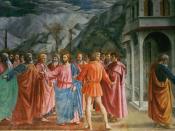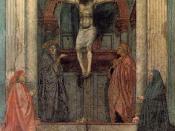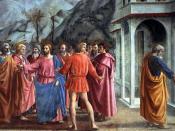The Renaissance covered the period between 1400 and 1600, although some disagree on exact dates. The word renaissance literally means 'rebirth' and is the French translation of the Italian rinascita. The two principal components of Renaissance style are the following: a revival of the classical forms originally developed by the ancient Greeks and Romans, and an interest in humanism and assertion of the importance of the individual. The Renaissance period in art history corresponds to the beginning of the great Western age of discovery and exploration, when a general desire developed to examine all aspects of nature and the world.
Masaccio, originally named Tommaso Cassai, was born in San Giovanni Valdarno, near Florence, on December 21, 1401. Masaccio was the first painter to employ both linear and aerial perspective in his frescoes (Saint Peter for the Brancacci Chapel in Florence's Church of Santa Maria del Carmine). In the most famous of these scenes, the Tribute Money, Masaccio invested the figures of Christ and the apostles with a new sense of dignity, monumentality, and refinement.
The Brancacci Chapel became a training ground for later painters, including Michelangelo, who copied Masaccio's figures. In the Trinity fresco (Santa Maria Novella, Florence), Masaccio, by employing Brunelleschi's methods using linear perspective, created for the first time a convincing illusionist space depicting a chapel.
Robert Campin was considered the Master of Flemalle. Campin was born around 1380 in Tournai, where he qualified as a master in 1406/07. He is considered one of the great innovators of the early Netherlands school as he moved from the decorative but flat stylization of International Gothic to a mode in which realism and perspective played a more significant role. Campin's works are characterized by a robust and highly developed realism and concern for the details of daily life,


